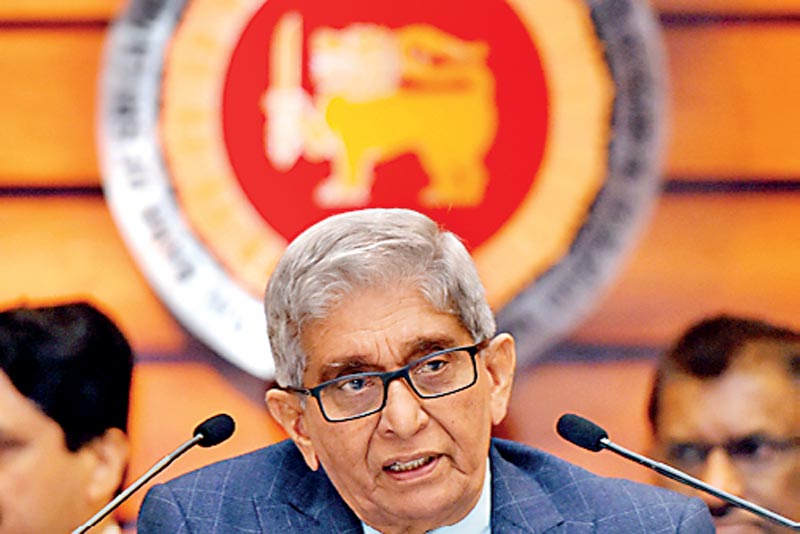Tuesday Apr 08, 2025
Tuesday Apr 08, 2025
Tuesday, 6 July 2021 01:53 - - {{hitsCtrl.values.hits}}

Central Bank Governor Prof. W. D. Lakshman
The Central Bank yesterday refuted rating agency concerns over letting licensed commercial banks and the National Savings Bank (NSB) invest in Sri Lanka’s International Sovereign Bonds (ISBs).
It said rating agencies continue to undermine the banking sector’s stability and fuel speculation regarding investments of licensed banks in the Government of Sri Lanka’s ISBs and Sri Lanka Development Bonds (SLDBs).
Fitch last week said Sri Lanka’s largest banks were the most susceptible to heightened sovereign risk due to their higher exposure to foreign currency-denominated Government securities and, in some cases, weaker capital positions.
However, the Central Bank in a statement said, with a view to facilitating investment opportunities in the country and to further encourage foreign currency inflows, the CBSL had allowed Licensed Commercial Banks (LCBs) and the National Savings Bank to invest funds sourced externally in US Dollar-denominated ISBs and SLDBs, equally splitting such investments into both ISBs and SLDBs, having considered all relevant risks involved including the following:
• Capital adequacy: To mitigate the risk arising from foreign currency exposure to the Government, CBSL has specified a capital charge under the Basel III framework for credit risk arising from foreign currency exposure to the Government and specifying a general capital charge for market risk under the Basel III framework for trading book investments in Government securities.
• Limit on foreign currency borrowings: With a view to mitigating the risk arising from their foreign currency borrowings, licensed banks are required to make such borrowings subject to a limit computed based on external credit rating and the capital adequacy ratios of the bank. The limit is expressed as a percentage of total assets, ranging between 5% and 10% as per the latest available audited accounts.
• Foreign currency liquidity ratio: Foreign currency liquidity positions are monitored through Basel III liquidity coverage ratio (LCR) and LCR monitoring tools to ensure that licensed banks keep adequate foreign currency liquid stocks to meet their foreign currency obligations.
• Integrated risk management framework (IRM): Licensed banks are required to put in place IRM techniques for monitoring and managing their risks including maturity mismatch and to ensure that adequate capital is available to meet various risks to which they are exposed. The IRM framework covers various potential risks, possible sources of such risks, and the mechanism to identify, monitor and control such risks at prudent levels.
• Market risk and foreign exchange risk management framework: Licensed banks are required to strengthen the market risk management, foreign exchange trading activities, market conduct and treasury operations, in order to mitigate any foreign exchange risks in licensed banks.
The sourcing of resources externally by LCBs and the NSB are on account of investment opportunities available for such institutions in the market and is purely based on the strength of their balance sheets and after having adopted prudent risk mitigation practices.
The Central Bank of Sri Lanka wishes to inform that all licensed banks comply with the capital adequacy and liquidity requirements which are based on Basel III International Standards and other key prudential requirements, thus indicating a resilient banking sector in the country.
Furthermore, the Government of Sri Lanka has reiterated its stance of ensuring that all its debt service obligations would be met on time, thus maintaining Sri Lanka’s unblemished record of servicing all its debt related obligations. Accordingly, arrangements are already in place to settle $ 1 billion ISBs maturing on 27 July.
Fitch in its report said Fitch-rated Sri Lankan banks had about one third of their combined assets exposed to the central Government as at the end of 2020, increasing the risk of sovereign stress causing major deterioration in their financial condition. Foreign currency Government securities held by Fitch-rated Sri Lankan banks accounted for around 6.4% of assets and 78% of equity at the end of 2020.

Discover Kapruka, the leading online shopping platform in Sri Lanka, where you can conveniently send Gifts and Flowers to your loved ones for any event including Valentine ’s Day. Explore a wide range of popular Shopping Categories on Kapruka, including Toys, Groceries, Electronics, Birthday Cakes, Fruits, Chocolates, Flower Bouquets, Clothing, Watches, Lingerie, Gift Sets and Jewellery. Also if you’re interested in selling with Kapruka, Partner Central by Kapruka is the best solution to start with. Moreover, through Kapruka Global Shop, you can also enjoy the convenience of purchasing products from renowned platforms like Amazon and eBay and have them delivered to Sri Lanka.
Discover Kapruka, the leading online shopping platform in Sri Lanka, where you can conveniently send Gifts and Flowers to your loved ones for any event including Valentine ’s Day. Explore a wide range of popular Shopping Categories on Kapruka, including Toys, Groceries, Electronics, Birthday Cakes, Fruits, Chocolates, Flower Bouquets, Clothing, Watches, Lingerie, Gift Sets and Jewellery. Also if you’re interested in selling with Kapruka, Partner Central by Kapruka is the best solution to start with. Moreover, through Kapruka Global Shop, you can also enjoy the convenience of purchasing products from renowned platforms like Amazon and eBay and have them delivered to Sri Lanka.